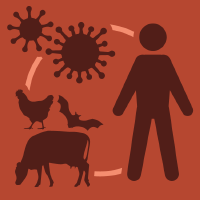Topic Menu
► Topic MenuTopic Editors


Zoonotic Vector-Borne Diseases of Companion Animals

Topic Information
Dear Colleagues,
Vector-Borne Pathogens (VBP) always held an exceptional place in the concept of One Health. At present, there are several reasons to address the problem of Zoonotic Vector-Borne Diseases (VBD) of Companion Animals with a fresh eye. The constantly increasing number of households that host companion animals, the augmenting diversity of companion animal species, the frequency of animal travel, newly recognized zoonotic VBP, climate change and the re-wilding of cities are some of these reasons. The Topic launched by MDPI, entitled “Zoonotic Vector-Borne Diseases of Companion Animals”, welcomes papers that address any aspect of the problem of VBD of both conventional (e.g., dogs and cats) and nontraditional or exotic companion animals. This Topic aims to update the knowledge about the identity, epidemiology, clinical impact, diagnostic approach, treatment options and zoonotic potential of companion animal zoonotic VBD through the publication of high-quality research and review articles, short communications, and case reports.
Prof. Dr. Anastasia Diakou
Prof. Dr. Donato Traversa
Topic Editors
Keywords
- companion animals
- zoonosis
- vectors
Participating Journals
| Journal Name | Impact Factor | CiteScore | Launched Year | First Decision (median) | APC | |
|---|---|---|---|---|---|---|

Animals
|
3.0 | 4.2 | 2011 | 18.1 Days | CHF 2400 | Submit |

Pathogens
|
3.7 | 5.1 | 2012 | 16.4 Days | CHF 2700 | Submit |

Veterinary Sciences
|
2.4 | 2.3 | 2014 | 19.6 Days | CHF 2600 | Submit |

Zoonotic Diseases
|
- | - | 2021 | 27.6 Days | CHF 1000 | Submit |

MDPI Topics is cooperating with Preprints.org and has built a direct connection between MDPI journals and Preprints.org. Authors are encouraged to enjoy the benefits by posting a preprint at Preprints.org prior to publication:
- Immediately share your ideas ahead of publication and establish your research priority;
- Protect your idea from being stolen with this time-stamped preprint article;
- Enhance the exposure and impact of your research;
- Receive feedback from your peers in advance;
- Have it indexed in Web of Science (Preprint Citation Index), Google Scholar, Crossref, SHARE, PrePubMed, Scilit and Europe PMC.

